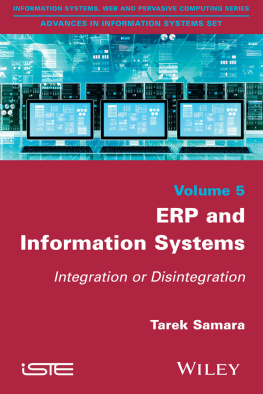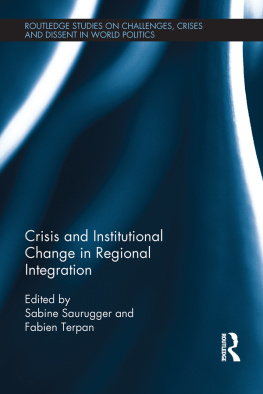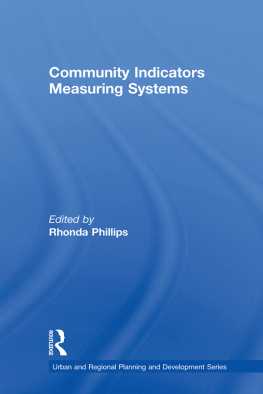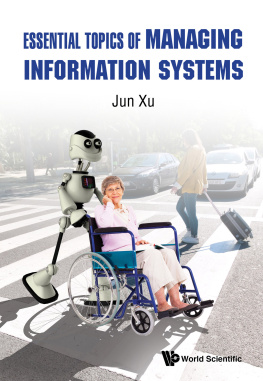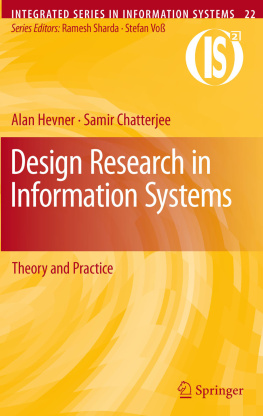Table of Contents
List of Tables
- 1: Definition of Research Terms
- 4: Literature Review: Factors Affecting the Relationships between the ERP Systems Evolution and IS Integration or Disintegration
- 5: Correlation Between Research Factors
- 6: Case Studies
- 7: Discussion: Relationships between Evolution of ERP Systems and IS Integration or Disintegration
- Conclusion
List of Illustrations
- 1: Definition of Research Terms
- Introduction
Guide
Pages

Advances in Information Systems Set
coordinated by
Camille Rosenthal-Sabroux
ERP and Information Systems
Integration or Disintegration
Volume 5
Tarek Samara
First published 2015 in Great Britain and the United States by ISTE Ltd and John Wiley & Sons, Inc.
Apart from any fair dealing for the purposes of research or private study, or criticism or review, as permitted under the Copyright, Designs and Patents Act 1988, this publication may only be reproduced, stored or transmitted, in any form or by any means, with the prior permission in writing of the publishers, or in the case of reprographic reproduction in accordance with the terms and licenses issued by the CLA. Enquiries concerning reproduction outside these terms should be sent to the publishers at the undermentioned address:
ISTE Ltd
27-37 St Georges Road
London SW19 4EU
UK
www.iste.co.uk
John Wiley & Sons, Inc.
111 River Street
Hoboken, NJ 07030
USA
www.wiley.com
ISTE Ltd 2015
The rights of Tarek Samara to be identified as the author of this work have been asserted by him in accordance with the Copyright, Designs and Patents Act 1988.
Library of Congress Control Number: 2015948074
British Library Cataloguing-in-Publication Data
A CIP record for this book is available from the British Library
ISBN 978-1-84821-896-3
Foreword
This book written by Tarek Samara gives a relevant overview of the evolution and impact of enterprise resource planning (ERP) on information systems (IS). As he is both a professional ERP expert and a researcher, the author has a deep understanding of what is at stake nowadays in IS strategy. This book might be considered to address a paradox that has rarely been highlighted in the literature. First, it provides the readers with rich insights into the history of ERP and, going back to MRP, explains how the integration process was made possible by enterprise applications. Second, it shows how this evolution of ERP can sometimes eventually lead in itself to IS disintegration. The author does not only explore the paradox, but he also pinpoints the main factors affecting the relationships between the evolution of ERP systems and the integration or disintegration of the IS.
Thus, the author gives us a useful framework. The seven factors identified by the author are the influence of economic crisis and competitiveness on the level of IS investment, the arbitrage made by companies considering the dependency on the ERP vendor, the success or failure of the ERP project management, the interoperability of the ERP with other applications running in the IS, the choice made between two evolution strategies of existing systems (urbanization or total overhaul), the complexity level of ERP and the evolution strategy of ERP vendors such as the expansion scope of ERP perimeter. The author shows how all these factors are crucial and critical for IS management.
The outline of the book is the following. After an introduction, the first chapter describes the research terms. The second chapter deals with ERP trends. The third chapter explains the research question and methodology. The fourth chapter explores the literature review. The fifth chapter analyzes the relationships between these research factors. In the sixth chapter, the validity of the research question is verified due to three case studies. are devoted, respectively, to a discussion (relationships between research factors and the evolution of ERP systems and IS) and research interests and limitations. Finally, a conclusion is given.
The contribution of the book is threefold. First, it offers a unique typology, which gathers all the different possible ERP evolution scenarios, and highlights their impacts on IS integration or disintegration. In this way, this book is an opportunity to take stock of the different available strategies to prevent the IS disintegration.
Second, the book takes into account the main challenges faced by chief information officers (CIOs) and gives us relevant clues to foster rational selection (and purchase) of an ERP package, and improves the success of its implementation. It is definitely a recent topic because of the growing pressure of ERP vendors on their clients, and of the general context of economic crisis that tends to kill a lot of innovative information technology (IT) projects.
Finally, the books key quality is to show that the future of ERP system evolution will not be a matter for vendors only. The book refers to the work of Freeman and raises the question of the stakeholders: firms, vendors, consultants, consultancy firms, etc. It is only by involving and taking into account all the stakeholders in the IS governance that solutions can be found. The author posits that stakeholders participation is a key point to engage enterprises in a positive IS evolution, and advocates such kinds of corporate policy.
For all these reasons, this book could be not only useful for researchers, teachers and students but also for practitioners and IT professional experts. Its content can provide fruitful insights to anyone who wants to know more about ERP issues and how to address them.
Philippe EYNAUD
August 2015
Introduction
The evolution of enterprise resource planning (ERP) packages and the principal types or degrees of information systems (ISs) integration is to be discussed in this introduction. The factors affecting the relationships between the evolution of ERP packages and the integration or the disintegration of the ISs are also discussed.
After the first expansion, between 1980 and 2000, from material requirements planning (MRP) and manufacturing resource planning (MRP II) toward enterprise resource planning (ERP) considering the modules like production planning, purchasing, manufacturing, sales, distribution, accounting and human resources [ESC 99], a second evolution seems to be in progress. In order to meet the new requirements of users, it is important to take into account the framework of the ERP, new modules like customer relationship management (CRM), e-business, supply chain management (SCM), product lifecycle management (PLM), business intelligence (BI), etc. For the purpose of our research, the package which is the result of the first expansion is termed ERP 1st Generation (1st G) and the package that is the result of the second evolution is called ERP 2nd Generation (2nd G).
Various authors have written about the degree and the maturity of information system (IS) integration. Depending on the architectures composition, many degrees or rates of IS integration are present today. Our study draws attention to two principal types or degrees of IS integration: a total integration of IS (TIIS) and a hybrid integration of IS (HIIS). Many studies have been conducted on the evolution of IS. This kind of research often analyzes paths of integration from a disintegrated information system (DIS) to an integrated information system (IIS). These paths could be not only from a DIS to a HIIS or to a TIIS, but also from a HIIS to a TIIS. However, according to our study, a possible way back or a regression from integration toward disintegration (from a TIIS to a HIIS or to a DIS) has never been highlighted. Our study will discuss whether this type of regression is possible due to the evolution of ERP systems.

